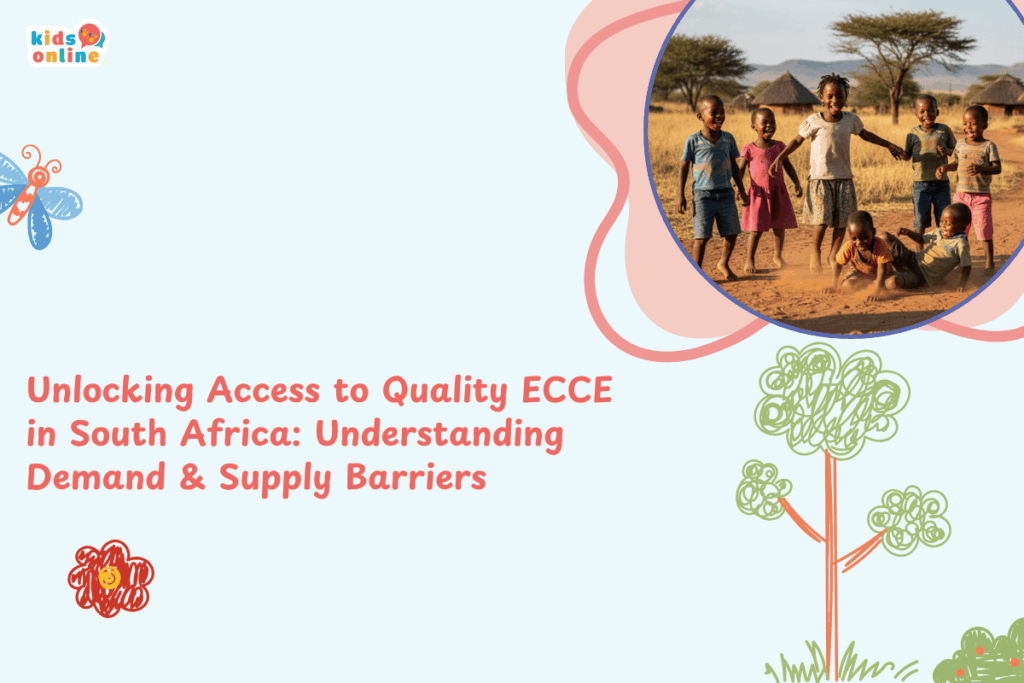Early Childhood Care and Education (ECCE) plays a transformative role in children’s development and family welfare. Yet in South Africa, many children aged 2 to 5 remain out of formal ECCE programmes. The 2021 policy brief by Moses sheds light on the complex demand-supply factors that influence enrolment and offers guidance for closing the gap.
Why ECCE Enrolment Matters
ECCE not only supports early learning and school readiness but also benefits caregivers and society at large. For families, enrolment can free time for work or education, particularly empowering women in households. For societies, expanded ECCE is linked to reduced welfare dependency, lower crime, and more equitable development.
However, South Africa’s enrolment rates remain low: in 2018, only ~ 53.3% of children aged 2–5 were in ECCE programmes—meaning nearly half of children were excluded.
Demand-Side Barriers to ECCE Enrolment
Household Income and Economic Status
Children from wealthier households are far more likely to be enrolled: nearly 3/4 of children in the richest 20% of households attend ECCE programmes, compared to less than half from the poorest 40%.
When a household has unemployed or economically inactive members, the probability of enrolment drops further by ~ 13.4%.
Mother’s Education
A mother’s educational attainment strongly predicts ECCE enrolment. Children whose mothers hold university or postsecondary qualifications are more likely to join ECCE, while those whose mothers have little formal education are less likely.
Distance and Spatial Access
Proximity matters. Children living in enumerator areas with no ECCE centre have enrolment rates as low as 5.8%, while in areas with centres nearby, enrolment jumps to 59%.
In rural, tribal, and farm areas, access is especially weak, making these zones critical for targeted intervention.
Supply-Side Constraints and Systemic Obstacles
Low Registration and Quality Compliance
Only ~ 40% of ECCE centres are fully or conditionally registered; ~ 16% are in process; ~ 42% remain unregistered altogether.
Unregistered centers are often excluded from funding and face challenges maintaining standards.
Unequal Distribution of Centres
ECCE programmes are concentrated in urban and well-resourced areas, leaving rural, farm, and tribal zones underserved.
If every area had an ECCE centre, enrolment would increase from ~ 34% to ~ 42% nationally — the biggest gains would be in farm and rural areas.
Financial & Administrative Barriers
Many centres struggle to register due to bureaucratic steps, compliance costs, and lack of capacity. Moreover, many centres do not qualify for government subsidies or cannot access them because of documentation or reporting constraints.

Policy Recommendations & Strategic Priorities
Based on Moses’s analysis, the brief proposes several interventions to boost equitable ECCE access:
- Address household constraints via demand-side support. Financial incentives, such as conditional cash transfers or vouchers, could encourage enrolment among poorer households. However, these must be designed carefully in environments with weak information systems.
- Expand supply in underserved areas. Establishing new ECCE centres (not necessarily full, brick-and-mortar ones) in rural, farm, and tribal zones is essential.
- Targeted, place-based supply strategies. Prioritize areas of greatest inequality and need rather than blanket expansion.
- Streamline registration & regulatory processes. Simplify compliance, reduce costs, and support centres to become formal.
- Further research on household dynamics. Especially the impact of unemployed adults in the household, as their presence correlates with lower enrolment.
Toward Universal, Inclusive ECCE by 2030
Expanding access is necessary but not sufficient. For genuine transformation, South Africa must ensure that new and existing centres provide quality, equitable, and safe learning environments. That includes qualified, supported staff; child-friendly infrastructure; and curriculum coherence. Policy planners must prioritize both demand stimulation (making ECCE accessible and affordable for families) and supply strengthening (building capacity, resources, and oversight).
By responding to both sides—household constraints and institutional barriers—South Africa can move closer to fulfilling the vision of universal high-quality ECCE by 2030.








